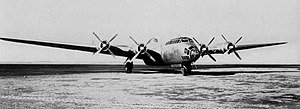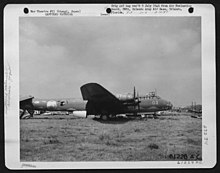| G5N Shinzan | |
|---|---|
 A Nakajima G5N2 Shinzan Kai A Nakajima G5N2 Shinzan Kai | |
| General information | |
| Type | Heavy bomber |
| National origin | Japan |
| Manufacturer | Nakajima Aircraft Company |
| Status | Retired |
| Primary user | Imperial Japanese Navy Air Service |
| Number built | 6 (2 of G5N1 & 4 of G5N2) |
| History | |
| First flight | 8 April 1941 |
| Retired | 1945 |
| Developed from | Douglas DC-4E |
The Nakajima G5N Shinzan (深山, "Deep Mountain") was a four-engined long-range heavy bomber designed and built for the Imperial Japanese Navy prior to World War II. The Navy designation was "Experimental 13-Shi Attack Bomber"; the Allied code name was "Liz".
Design and development
See also: Project Z (bomber project)The Nakajima G5N Shinzan originated due to the Imperial Japanese Navy's interest in developing a long-range attack bomber capable of carrying heavy loads of bombs or torpedoes a minimum distance of 3,000 nmi (5,600 km; 3,500 mi). To meet this requirement, it became apparent a four-engine lay-out would be necessary. As Japanese aircraft manufacturers lacked experience in building such large complex aircraft, the Navy was forced to search for a suitable existing foreign-made model upon which to base the new design. It settled on the American Douglas DC-4E airliner. In 1939 the sole prototype of this airliner (previously rejected by American airline companies) was purchased by Nippon Koku K.K. (Japan Airlines Co) and clandestinely handed over to the Nakajima Aircraft Company for dismantling and inspection.
The design that emerged from this study was for an all-metal mid-wing monoplane with fabric-covered control surfaces and powered by four 1,870 hp Nakajima NK7A Mamori 11 air-cooled radial engines driving four-bladed propellers. A long ventral bomb-bay, glazed nose and twin tailfins replacing the DC-4E's distinctive triple rudder were included. The DC-4E's retractable tricycle undercarriage was retained, as well as the original wing form and powerplant arrangement. Defensive armament comprised two 20mm Type 99 Model 1 autocannon (one in a power-operated dorsal and one in a tail turret), plus single-mount hand-operated 7.7mm Type 92 machine guns in the nose, ventral and waist positions.
The first prototype G5N1 made its maiden flight on 8 April 1941. Overall performance proved disappointingly poor however, due to a combination of excessive weight, the unreliability of the Mamori engines and the complexity of the design. Only three more prototypes were completed. In an attempt to salvage the project, two additional airframes were fitted with 1,530 hp Mitsubishi MK4B 12 "Kasei" engines and redesignated G5N2s. Although the Mitsubishi engines were more reliable than the original Mamori 11s, the aircraft was now even more hopelessly underpowered and further development of the type was halted.
Operational history
Of the six completed Shinzans, four were relegated for use as long-range Navy transports under the designation G5N2-L Shinzan-Kai Transport. The Allies allocated the code-name "Liz" to the aircraft, in the expectation it would be used as a bomber.
Variants



- G5N1 Experimental Type 13 Land-based Attack Bomber "Shinzan" (13試陸上攻撃機 深山 13-Shi Rikujō Kōgekiki "Shinzan")
- Prototype, two built. Initial named 'Experimental Type 13 Large-size land-based Attack Bomber' (13試大型陸上攻撃機 13-Shi Ōgata Rikujō Kōgekiki). Four-engined heavy bomber/torpedo bomber. Three-blade propeller, mounted four Mitsubishi MK4B Kasei 12 (1,530 hp) radial engines.
- G5N2 Test production "Shinzan Kai" (試製深山改 Shisei "Shinzan Kai")
- Supplementary prototype, four built. Four-blade propeller, mounted four Nakajima NK7A Mamori 11 (1,870 hp) radial engines. All G5N2s were rebuilt to G5N2-L in 1943.
- G5N2-L "Shinzan Kai" Freighter (深山改輸送機 "Sinzan Kai" Yusōki)
- Long-range Navy transport conversion. All G5N2-Ls were deployed to 1021st Kōkutai, Katori Air Base.
- Nakajima Ki-68
- Proposed Army bomber prototype version of the G5N1. Engines were planned Mitsubishi Ha-101, Ha-104, Ha-107, Nakajima Ha-39 or Ha-103 engines. Discontinued in 1941.
- Kawasaki Ki-85
- Proposed Army bomber version of the G5N1. Four Mitsubishi Ha-111M engines. Full-scale mock-up was built in 1942, discontinued in May 1943.
Operators
- Imperial Japanese Navy Air Service
- 1021st Kōkutai
Specifications (G5N2)
Data from Japanese Aircraft of the Pacific WarFamous airplanes of the world (1984)
General characteristics
- Crew: 7 (G5N1/2), 6 (G5N2-L)
- Capacity: 4,000 kg (8,800 lb) freight (G5N2-L)
- Length: 31.02 m (101 ft 9 in)
- Wingspan: 42.12 m (138 ft 2 in)
- Height: 8.8 m (28 ft 10 in)
- Wing area: 201.8 m (2,172 sq ft)
- Empty weight: 20,100 kg (44,313 lb)
- Gross weight: 28,150 kg (62,060 lb)
- Max takeoff weight: 32,000 kg (70,548 lb)
- Powerplant: 4 × Nakajima NK7A Mamori 11 14-cylinder air-cooled radial piston engines, 1,395 kW (1,871 hp) each
- Propellers: 4-bladed Sumitomo/Hamilton constant-speed propellers
Performance
- Maximum speed: 420 km/h (260 mph, 230 kn)
- Cruise speed: 278 km/h (173 mph, 150 kn)
- Range: 4,260 km (2,650 mi, 2,300 nmi)
- Service ceiling: 7,450 m (24,440 ft)
Armament
- Guns:
- 2× 20 mm Type 99 cannons
- 4× 7.7 mm (0.303 in) Type 92 machine guns
- Bombs:
- 2,000-4,000 kg (4,408-8,816 lb) bombs or torpedoes
- 2× 1,500 kg torpedoes
- 2× 1,500 kg bombs
- 4× 800 kg bombs
- 12× 250 kg bombs
- 24× 60 kg bombs
- 2,000-4,000 kg (4,408-8,816 lb) bombs or torpedoes
See also
Related development
Aircraft of comparable role, configuration, and era
- Avro Lancaster
- Boeing B-17 Flying Fortress
- Consolidated B-24 Liberator
- Handley Page Halifax
- Heinkel He 277
- Nakajima G8N
References
Notes
- ^ Famous Airplanes of the World (1984), p. 11.
- Francillon 1979, p. 423.
- ^ Francillon 1979, p. 425.
- ^ Famous Airplanes of the World (1984), p. 32.
- Famous Airplanes of the World (1984), p. 2.
Bibliography
- Collier, Basil. Japanese Aircraft of World War II. New York: Mayflower Books, 1979. ISBN 0-8317-5137-1.
- Francillon, René J. (1979). Japanese Aircraft of the Pacific War (2nd ed.). London: Putnam & Company Ltd. ISBN 0-370-30251-6.
- Nakajima, Navy heavy experimental attack bomber Shinzan / Renzan, Famous Airplanes of the World No. 90 , Bunrindō (Japan) October 1977.
- Nakajima Shinzan / Renzan, Famous Airplanes of the World No. 146, Bunrindō (Japan) November 1984.
- Illustrated warplane history #5 Imperial Japanese Navy warplane, Green Arrow publishing (Japan), June 1994. ISBN 978-4-76633-161-5
External links
![]() Media related to Nakajima G5N Shinzan at Wikimedia Commons
Media related to Nakajima G5N Shinzan at Wikimedia Commons
| Nakajima aircraft | |||||||||||||||||||||
|---|---|---|---|---|---|---|---|---|---|---|---|---|---|---|---|---|---|---|---|---|---|
| Imperial Japanese Navy types |
| ||||||||||||||||||||
| Imperial Japanese Army types |
| ||||||||||||||||||||
| WW2 Allied reporting names | |||||||||||||||||||||
| Imperial Japanese Navy aircraft designations (short system) | |
|---|---|
| Fighters (A) | |
| Torpedo bombers (B) | |
| Shipboard reconnaissance (C) | |
| Dive bombers (D) | |
| Reconnaissance seaplanes (E) | |
| Observation seaplanes (F) | |
| Land-based bombers (G) | |
| Flying Boats (H) | |
| Land-based Fighters (J) | |
| Trainers (K) | |
| Transports (L) | |
| Special-purpose (M) | |
| Floatplane fighters (N) | |
| Land-based bombers (P) | |
| Patrol (Q) | |
| Land-based reconnaissance (R) | |
| Night fighters (S) | |
| X as second letter is for experimental aircraft or imported technology demonstrators not intended for service, Hyphenated trailing letter (-J, -K, -L, -N or -S) denotes design modified for secondary role, Possibly incorrect designation, but used in many sources | |
| Imperial Japanese Navy official aircraft names | |||||||||
|---|---|---|---|---|---|---|---|---|---|
| Fighters |
| ||||||||
| Heavy bombers | |||||||||
| Bombers | |||||||||
| Patrol | |||||||||
| Reconnaissance | |||||||||
| Trainers | |||||||||
| Transports | |||||||||
| Miscellaneous | |||||||||
| Special-purpose aircraft | |||||||||
| With some exceptions for rockets, jets and repurposed aircraft, names chosen were for: 1. Winds, 2. Lightning, 3. Nighttime lights, 4. Mountains, 5. Stars/constellations, 6. Seas, 7. Clouds, 8. Plants, 9. Skies, 10. Landscapes, and 11. Flowers. Published translations disagree, and many are simplified, especially for plants, where the Japanese referred to a specific variety and the common translations only to the broader type. | |||||||||
| World War II Allied reporting names for Japanese aircraft | |
|---|---|
| Aircraft in Japanese service |
|
| Foreign aircraft thought to be in Japanese service | |